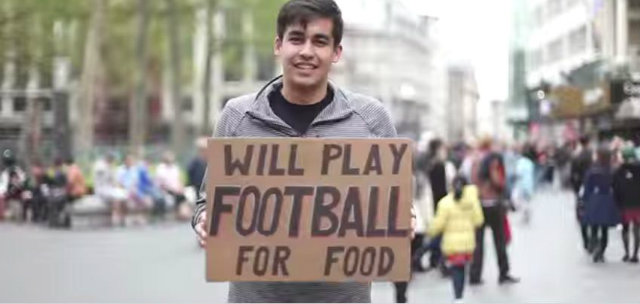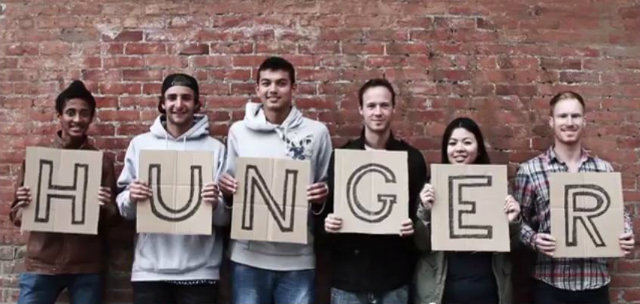SUMMARY
This is AI generated summarization, which may have errors. For context, always refer to the full article.

MANILA, Philippines – Can sports help feed the hungry?
In Britain, football fans are sustaining food banks across and outside the country. (READ: What are food banks?)
Footy for Food (FFF), a non-profit and volunteer-run organization, uses sports as a “vehicle for social change.” FFF raises awareness about hunger, and at the same time, hosts sporting events, games, and tours to raise funds and supplies for food banks.
FFF currently supports food banks in “football nations” like the UK, Spain, France, and Brazil. It also has plans of expanding its reach to other countries.
Watch how FFF used Britain’s love for football as a tool for social change: Will you play football for food?
‘Hungry for change’

FFF was launched by Richard Loat in 2013, following the success of his earlier organization Five Hole for Food (FHFF) from 2010.
FHFF is the same kind of non-profit organization, but focuses on hockey in Canada. During its first 3 years of operation, it was able to raise over 500,000 pounds of food for local food banks across Canadian cities.
To generate more interest and funding, volunteers hold hockey games along streets, parking lots, and even in a ship in the middle of the ocean. FHFF works with professional and volunteer hockey teams.
Those who want to play must donate either supplies or money for the food banks.
Aside from partnering with the private sector, Loat said his organizations meet most of its volunteers through Facebook and Twitter.
“It’s been exciting to lead a vision where people around the world can host sporting events as a way of creating change for local communities,” Loat explained in an e-mail interview.
“Our idea is built upon taking a country and their passion for sport to create a movement within the country.”
Watch how Canada’s passion for hockey was used to fight hunger: Made from Canada
Pinoy basketball

Basketball is big in the Philippines. (READ: Shooting hoops, a Filipino passion)
We have the Philippine Basketball Association (PBA), college basketball like the UAAP (University Athletic Association of the Philippines) and the NCAA (National Collegiate Athletic Association), the Palarong Pambansa for young athletes, and of course we have street basketball.
In almost every barangay (village), there is a basketball court. Even in remote areas, one can probably find an improvised hoop somewhere.
Just about anyone can play – young and old, women and men, short and tall, in rubber shoes or slippers – as long as they know how to play as a team.
The book Pacific Rims by Rafe Bartholomew, published in 2010, captures the way basketball is integrated in the everyday lives of many Filipinos.
“The people of the Philippines are the biggest basketball fans I have ever seen. I was there during December as an aid worker helping respond to Typhoon Yolanda (Haiyan) and saw it first hand,” Loat said.
Loat sees a great potential in turning the country’s most popular sport into a weapon against hunger.
“I would like to start ‘Hoops for Food,’ an equivalent program but using street basketball, in the Philippines and work to build it there and in other basketball nations,” he added.
The Department of Social Welfare and Development (DSWD) is currently planning a system for community-based food banks aiming to feed society’s most vulnerable members, especially those who have been relocated to resettlement areas.
DSWD aims to replicate the successful model used in South Korea’s food banks, however, the government is yet to translate these good ideas into action.
Loat expressed interest in working with DSWD and the Department of Education in pursuing his plans.
He encourages Filipino basketball fans to channel their shared passion into meaningful projects like food banks. “All it takes is the help, support and commitment of a dedicated few in the country to help us launch this and build from there.”
As the country waits for the government to establish efficient and sustainable food banks, it does not hurt to explore other ways on how people can help the less fortunate.
Loat hopes that the Philippines, too, can make the most out of its love for sports as a way to help feed the hungry. – Rappler.com
To learn more about these initiatives, you may visit their websites here and here. You may also them at info@footyforfood.com for queries or suggestions regarding the planned ‘Hoops for Food.’ You may also contact us for more details.
Please share your ideas with us on how we can transform the country’s love for sports into meaningful projects like food banks. You may contact us at move.ph@rappler.com. Be part of the #HungerProject.
Add a comment
How does this make you feel?
There are no comments yet. Add your comment to start the conversation.